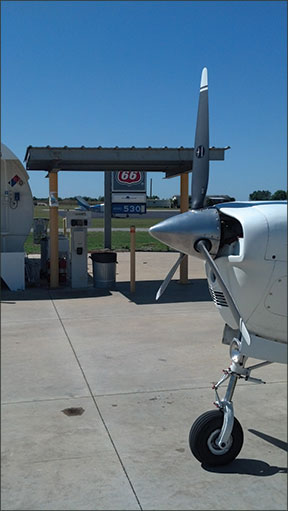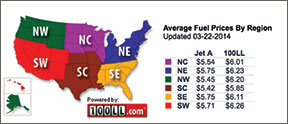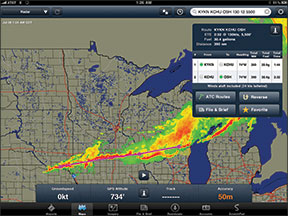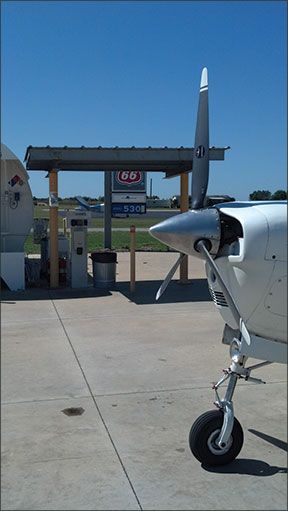In their older years, my parents were cheapskates. When I visited them in their Southern Texas retirement community, they always were delighted to share their favorite places, those with senior discounts, dollar-breakfast specials and cheap all-you-can-eat buffets. The same proved true when buying unleaded: I thought it odd they would drive six miles round-trip to save $0.05 a gallon. After my father filled his tank, I asked how much he had put in. Twelve gallons, he answered; he just saved 60 cents. I pointed out it took us 15 minutes to save 60 cents, so he was paying himself about $2.40 an hour…just a little observation. His answer was: 1) he’s retired, so he likes saving money, 2) polite people keep their math to themselves, and, 3) nobody likes a smart ass.

288
Many of us abhor unnecessary spending, but pilots seem to elevate frugality to an art form, especially when it’s time to purchase fuel. The tendency is amplified because a crazy thing about avgas is its price variability: It isn’t a mere five cents cheaper; it can be a dollar or more. Also, we’re not talking about 12 gallons; many personal airplanes can carry 100 gallons or more. Within 100 nm of my home airport, I can find 100LL ranging from $5.33/gallon to $7.94/gallon. That’s a 40 percent price difference! I think I’d be crazy to top my tanks at $7.94, but how far am I willing to fly to save a buck or two? To address it another way, how many dollars per gallon is your safety worth?
Preventable mistakes
When you read the volumes of accident reports citing fuel exhaustion as a probable cause, it’s easy to face-palm and conclude the PIC was an idiot. But if you read between the lines, often you can easily infer the unstated root-cause motivation was cheap gas. Here’s a great example, from NASA’s Aviation Safety Reporting System (ASRS).
“Flew into this airport 4 days previously, noted that I had about 1 hour of fuel remaining, i.e., a quarter of a tank. On morning of incident, went to airport to fly 20 miles south for fuel. Due to fuel tank being ‘low’—no fuel will show up on inspection when less than a quarter. The tank gauges showed enough fuel, the previous trip should have allowed enough fuel. On takeoff, all was normal till 5 minutes after takeoff when engine quit. [I] switched to other tank, turned back to airport. Engine restarted and ran another 1 minute and quit. Attempted to return to the airport, but unable. Elected to land alongside highway.
“Not sure at this point why engine quit, but know I should have added enough gas to be sure there was no possibility. Not sure why my previous experience led me to believe there was enough gas, but hindsight tells me why I would have not been more sure when I took off. When a fuel tank shows no visible fuel, put fuel in regardless of what previous experience tells one how much should still be in the tank or what fuel gauge shows versus what is previously shown. No gas visible means no gas and not 4 gallons that I think is still there.”
In this explanation, the pilot discloses two telling facts: First, he or she departed with low tanks to fly 20 miles to get fuel and, second, he or she thought there was enough for the trip, but in hindsight realized that maybe some should have been added—even at the higher price—before launching for Cheap Gas Regional.

288
From the narrative, we know the pilot had the option to add fuel before takeoff, but instead chose to fly 20 miles to get it. I surmise, with my clever pilot’s intuition, that fuel at the field 20 miles away was substantially cheaper than at the departure airport. And sweetening the deal was the additional savings opportunity of filling nearly empty tanks.
A similar accident happened in the fall of 2013. Paraphrasing the NTSB report (with my not-so-subtle additions of current fuel prices at the respective airports identified in the report), gives us the following:
According to the pilot of the Beech C90 King Air, the airplane originated the day’s flight sequence at the home airport where Jet A is sold for $5.50/gallon. In the morning, the accident plane traveled 45 nm to pick up a passenger. Jet A is currently sold for $5.88/gallon at this first stop. The plane continued 165 nm to the destination airport at a larger city within Class C airspace, where the local jet center sells Jet A for $5.75/gallon. Later, the King Air departed the airport with the second most expensive fuel of the day and flew 165 nm to return the first passenger. After dropping off the first passenger at the airport with the most expensive fuel of the three stops, the pilot chose to continue back to the home airport, where fuel was cheapest.
On final approach to the airport with the cheapest fuel, the pilot noticed a “master warning or caution” annunciator light illuminated. The pilot was “pretty sure” it was related to a fuel quantity/distribution issue. Shortly, both engines of the King Air simultaneously stopped running. The airplane impacted level terrain and an irrigation ditch about 1.2 miles short of the runway. The landing gear, one propeller, and one engine were separated from the airplane during impact, and the wings and fuselage sustained substantial damage. The accident resulted in two minor injuries and one serious. Only trace amounts of fuel were observed at the scene.
With respect to the above accident, it’s my supposition that the pilot was concerned about fuel prices. There could have been many factors playing into the decision—a matter of convenience, get-home-itis or simply poor fuel planning—but I can’t help wondering whether knowing the fuel at the home base was cheaper factored in, even if only in a subliminal way.

288
Whatever the reasoning, I can say for certain that price-driven scenarios leading to fuel exhaustion play out on a regular basis. It does not appear to be a motive that gets acknowledged in accident reports.
Flight Planning and Fuel
Have fuel prices really become a foundation of aeronautical decision-making? Most electronic flight bag apps have fuel-price features, and flight-planning Web sites like 100LL.com and AirNav.com allow pilots to check prices and optimize their cross-country routes to save money. The planners will help you “game out” the proposed flight and strike a balance between safety and cost. It seems like a reasonable choice to make. Why spend more than you have to? I try not compromise safety, but my longest cross-country routes have always been planned based on gas prices.
Take my trip from Idaho to Oshkosh, Wis., in 2010. I flew a Cessna 182 with 60-gallon tanks (55 usable). The four fuel stops I planned for the 1000-plus nm trip were based exclusively on gas prices. With 100 gallons burned to get there, that choice offered about $80 in savings each way.
What are the consequences of fuel-based routing? On that same Oshkosh trip when I got to my second fuel stop, I discovered the pump was locked, the phone number provided wasn’t answering, and the sun was getting low. Fortunately, I planned conservatively and had half a tank remaining, so the 55 nm diversion from Torrington, Wyo. (KTOR), to Pine Bluffs, Wyo. (82V), was in easy reach. I’d noted Pine Bluffs as an alternate fuel stop in my planning because it also had cheap gas.
A ridiculously frugal pilot would plan to arrive at the cheapest fuel stop with the least amount of fuel in the tanks, but with legal reserves. If the cheapest fuel stop is closed, out of gas or otherwise unavailable, the frugal pilot may not have many safe options left in the tanks without flying on reserve fuel. The most foolish cheapskate is someone who has rationalized that the definition of reserves is the amount of gas required to get to the next cheap-fuel stop on vapors…but let’s get back to the story.
The extra 55 nm to get cheap gas slowed our progress so it was late when we arrived at our next stop, Yankton, S.D. (KYKN). As we approached Yankton, we could see on XM radar something else headed for the airport—a slowly building line of thunderstorms. The squall line wasn’t moving as much as it was just sitting in place and expanding.
As we got closer to the airport, I remember intently watching the line of storms on radar. It wasn’t like we were playing chicken, but it was still a race to the aerodrome with us winging at 130 knots and the storm essentially stationary, but getting fatter and fatter from its base five-to-10 nm from the airport. As we got closer, my CFI-I and I were plotting whether we would be able to beat the system to our pit stop. Fifteen minutes from the airport, it was clear we would win the race—ahhh…more cheap gas. We were staying ahead of the game. The part we forgot was that we also would have to depart before the storm arrived.
As I added the cheap gas to the tanks, my double-I was on the horn with Flight Service, getting an IFR clearance to ensure we got out. They pointed out the red stuff on radar while he pointed out it was much bigger in real life, and could they please hurry up with the clearance.
We were still VFR, but we could see the cloud deck moving over the airport and the lightning was not as far away as I would like it. The best choice we had was to get out of its way as soon as the tanks were full. But again, why did we land so close to a storm in the first place? All together now: Cheap gas. As we pulled away from the pumps, the winds began to wail. We cleared the field and made our way to Sioux City, Iowa (KSUX), a safe port out of the storm’s path. In retrospect, had I not been fixated on cheap gas, I would have simply diverted to KSUX in the first place. The ForeFlight screen shots on the opposite page tell part of the tale.
Dumb and Dumber
My final observation about the lure of inexpensive fuel at the expense of safety involved a Piper Twin Comanche. The plane had a leaking tank that was repaired just prior to the accident flight. Before the repair, the owner drained the fuel into metal Jerry cans. It was automobile gasoline.
After the tank repair, the pilot decanted the mogas back into the repaired aircraft tank and headed for the runway. Not only was autogas not approved, the Jerry cans likely introduced significant contamination: The fuel screens were found completely clogged. There were other significant contributing factors to the accident as well, including full flaps extended and automobile oil in the engine, but the desire to burn mogas in an engine neither certified nor approved for it, transferred in tanks poorly suited for it, proved fatally stingy.
Don’t be Fuelish
In some cases, the root cause of a fuel exhaustion accident is simply lack of knowledge about the aircraft system, either burning more gas than planned, not knowing the aircraft’s capacity or failing to understand the tank-switching systems. These human factors easily can be explained in accident reports—the pilot misread the fuel gauge, miscalculated the burn rate, failed to check fuel levels, or accidently turned off the fuel instead of switching tanks. All of these causes are overtly stated in accident reports.
What you don’t find as often, if ever, is the clear admission of an obvious truth: The pilot was cheap. It is rare indeed for the NTSB to simply say something like the following: “The pilot took off with near-empty tanks from an airport with expensive fuel, presuming he had enough aboard to make it to an airport with much cheaper gas. He was mistaken.”
Like I tried to tell my father, sometimes saving a few cents is not worth it. I don’t drive six miles out of my way to save five cents a gallon because my time is worth more than $2.40 an hour. Also, I have learned you don’t need to dance with an oncoming thunderstorm just to save a couple of bucks.
I flight plan for cheap gas, but I have learned to be very willing to add a few gallons or even top off with the high-priced stuff because full tanks give me more options. I decided my life is worth sometimes paying $2.40 a gallon more than I have to. I also prefer not to have too much air in my tanks; it leads to running out of gas, which leads to running out of options.




